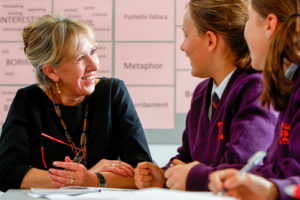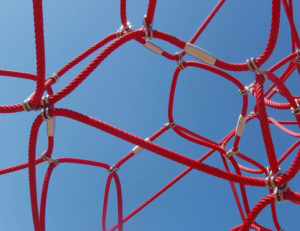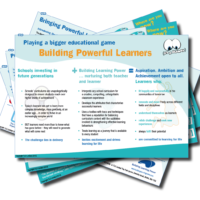Last week we looked at the classroom focused framework…the Teachers’ Palette, discovering how it has developed in response to changing circumstances and a recognition of the importance of classroom culture. This week we look more closely at the subtle changes teachers of learning power need to make; in designing activities, coaching progress and making talk about learning commonplace.
The page below offers glimpses of some of the important aspects of the teacher’s role; one that embraces building powerful independent learners.
Developing students with the power to learn is a long term endeavour. It requires more than reading a BLP book or having a ‘stuck’ poster, displaying a picture of the Supple Learning Mind or adding ‘yet’ to ‘I can’t do it’. The approach has implications not just for student learning, but for staff learning too; learning to teach a bit differently.
Developing students’ power to learn involves teachers in…
…using the sort of talk that draws out learning as a process
Deep talk about learning is what sets learning powered classrooms apart. Learning and how it works isn’t just talked about at the beginning of a term or year but is embedded in the everyday conversations of the classroom.
- What do we mean when we say learning?
- When and where is it best?
- What helps you to do it?
- How does it feel? What hinders your learning?
- What made it so successful?
- What did you contribute?
- How did you make sense of that?
 And later learners are enabled to become meta-learners with questions such as:
And later learners are enabled to become meta-learners with questions such as:
- How do you plan to go about learning?
- Which learning strategy will work best here?
- How will you monitor how it’s going?
- How can you review how your learning has gone?
Note that the examples of teacher talk on the card above focus on supporting the learner work things out for themselves.
…using a coaching approach to teaching
 “Expert tutors often do not help very much. They hang back, letting the student manage as much as possible. And when things go awry, rather than help directly they raise questions: ‘Could you explain this step again? How did you… ?’” (Mark Lepper)
“Expert tutors often do not help very much. They hang back, letting the student manage as much as possible. And when things go awry, rather than help directly they raise questions: ‘Could you explain this step again? How did you… ?’” (Mark Lepper)
When we are curious we are genuinely interested in learning. Curiosity lies at the heart of coaching, hence coaches are effective listeners and ask questions to open dialogue without sounding like an interrogation. Coaching aims to enable people to see what they are doing more clearly and discover their own ways to improve. A coaching approach:
- helps people to explore their challenges, problems and goals
- provides an objective view of peoples actions to enable them to see things as as they really are
- enhances motivation and raises self esteem
- builds curiosity and encourages learning
Above all, coaches resist offering solutions. Offering solutions does little to secure learning as the student hasn’t been allowed to confront and engage with the problem and find their way forward. Learning powered teachers adopt a coaching role. But…
- the content /skill needs to be discoverable so teachers need to know the subject well
- the learner needs to be able to discover it for themselves hence teachers need to know learners well.
The key is knowing when to coach and when to teach/tell. Hence coaching is one of the highest teaching skills, requiring both a deep understanding of both subject content and the students as learners
…thinking ‘split-screen’ when designing learning
Whether we realise it or not, all lessons have a dual purpose:
- The content dimension, with material to be mastered
- The ‘epistemic’ dimension, with some learning skills and habits being exercised.
In conventional lessons teachers remain the focus of attention and initiator of activity, and where the epistemic dimension is not acknowledged, students may gain habits of compliance and dependence, rather than curiosity and self reliance. In developing learning power, teachers are making conscious choices about which habits to introduce and stretch and how best to couple these with content so that lessons become more interesting and challenging. Through such overt coupling of content and specific types of process, students come to know, understand and take control of their learning behaviours – they knowingly use and develop the whole range of learning behaviours.
The first sentence is the important one – Whether we realise it or not . . .
It reminds us that learning behaviours happen;
- even if we don’t intend that they do
- even if we haven’t planned for them
- even if we’re unaware of them
- even if students are unaware of them.
Learning behaviours are strengthened when students are aware of the behaviours that they are using and are afforded opportunities to reflect on how well they are using them. So it is that teachers need to:
- be aware of the learning behaviours that fit well with the lesson content
- plan activities to ensure this happen
- plan opportunities for reflection on how the content is being acquired,
- plan for reflection on the learning behaviours being exercised and strengthened,
- reflect on how content acts as the vehicle for exercising the learning behaviours while in turn the learning behaviours enhance their understanding of content.
…designing rich, challenging activities
 Learning is always an emotional business and learning how to manage this is best done ‘on the job’ in the course of learning rather than as a separate stand alone activity. Emotional engagement is a prerequisite of powerful learning, it’s what gets you interested enough to be willing to put in the effort to get better and see the value of pushing yourself. So lessons aren’t just designed to make use of different kinds of learning behaviours but to give those behaviours a good work-out. Activities are designed to:
Learning is always an emotional business and learning how to manage this is best done ‘on the job’ in the course of learning rather than as a separate stand alone activity. Emotional engagement is a prerequisite of powerful learning, it’s what gets you interested enough to be willing to put in the effort to get better and see the value of pushing yourself. So lessons aren’t just designed to make use of different kinds of learning behaviours but to give those behaviours a good work-out. Activities are designed to:
- be challenging and where being stuck and confused are regular and fruitful experiences.
- give students the opportunity to ‘learn what to do when they don’t know what to do’ – to work on wild tasks, rather than tame ones, where there’s plenty of scope to get lost and perplexed.
“The presence of challenging learning intentions has multiple consequences. Students can be induced to invest greater effort, and invest more of their total capacity than under low demand conditions.”
(Hattie, Visible Learning)
Questions you might like to consider.
Something to think about
- How skilful are you / your teachers at balancing the competing pressures of coaching whenever possible and teaching whenever necessary?
- To what extent are students experiencing high challenge activities as opposed to ‘low demand conditions’?
- Is classroom talk sufficiently sophisticated and intentional to enable students to gain a deep understanding of the processes of learning?
- Are curriculum plans sufficiently detailed to identify where/when/how specific learning behaviours could be exercised?



No comments yet.